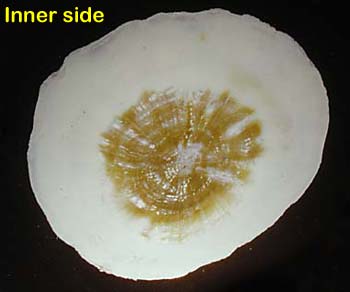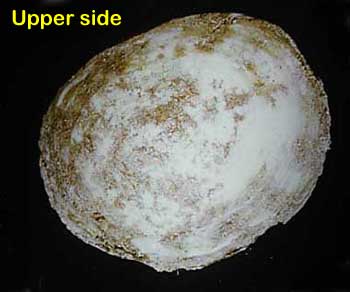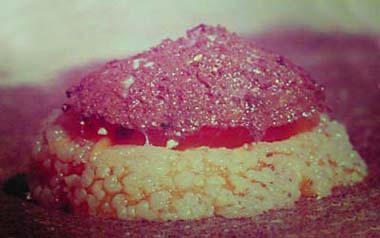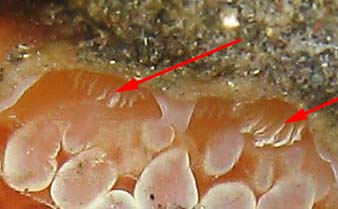This species has been observed on Reunion, Mauritius and Mayotte Islands
Species characteristics : A notaspid, with a large external shell covering the dorsum. The shell, is usually covered with encrusting plant and animal growths. |

|
|
| Showing species characteristics... | Photo Philibert Bidgrain |
|
See more about : Sightening and mating periods
See more about : Umbraculum umbraculum variability in Southwest Indian ocean
Remarks :
Identification confirmed by Bill Rudman and Nathalie Yonow
Synonymous : (according Worms) :
- Very numerous synonymous, see worms
Bibliographic data :
Shell description : Cone shaped, more or less flattened, ovate with an exenterated apex. The upper face is white, and bears numerous circular growth lines, and irregular wide axial folds. It bears a brown epidermis. The inner side is glossy yellowish white, with a brown central disk bearing radiate folds (see M. Jay photo)
Even when crawling the animal does not elongate and the position of the head can only be determined by the tubular rhinophoral tentacles which extend out from beneath the shell.
The large gill which lies under the shell arround the front and down the right side of the body. Usually the gill is hidden under the shell, but when the animal is feeling safe, it can extend the gill out from under the shell.
Tom Thompson (1970) reported some facts and figures about an egg mass produced by a 16 cm long animal from N. Stradbroke Id, Queensland. The uncoiled ribbon was 100 cm long and 22 mm high. There were on average 37 eggs in each capsule present on the ribbon.
In eastern Australia, this species can be found from the intertidal to a depth of at least 274 meters where it is completely colourless.
U. umbraculum is a sponge feeder, and has been recorded on a number of different species of the Demospongia, including Tethya sp., Aaptos aaptos, Ancorina alata, and Plakina trilopha. The proboscis does not evert, so in feeding, the anterior cleft must be spread open so that the mouth can be pressed against the sponge colony.
Material examined by Nathalie Yonow ( see reference/publications).
Two specimens collected from Tamarin (Mauritius), 24 October 1985, size : 80x60 and 50x40 mm. And two from Flic en Flac (Mauritius), 15 October 1985, size 60 and 70 mm
References :
Bill Rudman Seaslug site : Sea Slug Forum : Umbraculum umbraculum
Nudipixel Umbraculum umbraculum
Publications :
Thompson, T. E. (1970) . Eastern Australian Pleurobranchomorpha (Gasteropoda, Opistobranchia). Journal of Zoology, London , 160 : 173-198
Willan, R.C. (1984). A review of diets in the Notaspidea (Mollusca: Opisthobranchia). Journal of the malacological Society of Australia , 6 : 125-142
Yonow, N. and Hayward , P. J. (1991). Opistobranches de l'île Maurice, avec la description de deux espèces nouvelles (Mollusca : Opistobranchia) Revue française d'aquariologie herpétologie, 18 (1), 1-30
Other photos of Umbraculum umbraculum :
Philibert Bidgrain The same specimen found in Etang salé. The position of the head can only be determined by the tubular rhinophoral tentacles which extend out from beneath the shell.
|
 |
 |
Maurice Jay The Shell : The inner side is glossy yellowish white, with a brown central disk bearing radiate folds. The upper side is white, and bears numerous circular growth lines, and irregular wide axial folds. It bears a brown epidermis. The animal : Size : 116 x 103 x 18 mm |
 |
 |
Philibert Bidgrain Reunion, Etang salé on rocky coast, 23 October 2006, size 70-80 mm |
|
Underside of this specimen. In this photo you can observe the mouth (orange)  |
This specimen probablly eating a sponge. The proboscis does not evert, so in feeding, the anterior cleft must be spread open so that the mouth can be pressed against the sponge colony.  |
 |
Philibert Bidgrain Reunion, Etang salé on rocky coast, 30 October 2006, size 110 mm The large gill which lies under the shell arround the front and down the right side of the body. Usually the gill is hidden under the shell, but when the animal is feeling safe, it can extend the gill out from under the shell.
|
Philibert Bidgrain Reunion, Etang salé on rocky coast, 29 November 2006, animal size 140 mm, shell size : 80 mm The position of the head can only be determined by the tubular rhinophoral tentacles which extend out from beneath the shell. The eye (a) corresponded to the black spot on the rhinophoral base. |
 |
 |
The large gill (b) which lies under the shell arround the front and down the right side of the body. Usually the gill is hidden under the shell, but when the animal is feeling safe, it can extend the gill out from under the shell. animal size 140 mm, shell size : 80 mm  |
 |
Christophe Cadet Reunion, Etang salé, on the rocky coast, less 1 m, September 2009, size : 25 mm
|
Philibert Bidgrain Reunion, Etang salé , on the rocky coast, less 1 m, 11 February 2007, animal size : 18-20 mm
On this small specimen, the orange body is circular, with large and white rounded pustules. |
 |
 |
Elisabeth Morcel Reunion, La saline lagoon, Coco Beach, less 1 m, 5 January 2010, size: shell, 100 mm Partially eaten by a predator ???
|
Alain Barrère Reunion, Etang salè lagoon, less 1 m, 13 February 2011, size : 90-100 mm Tom Thompson (1970) reported some facts and figures about an egg mass produced by a 16 cm long animal from N. Stradbroke Id, Queensland. The uncoiled ribbon was 100 cm long and 22 mm high. There were on average 37 eggs in each capsule present on the ribbon. |
 |
With its spawn |
Seb Vasquez Reunion, Etang salè on the rocky coast, less 1 m, 5 February 2015 During the night |
.jpg) |
More photos from Indian Ocean
See more about : Umbraculum umbraculum variability in Southwest Indian ocean
Reunion, Umbraculum umbraculum crawling during the night, at Saint Gilles, by Béatrice Delteil
Mauritius, drawing of an Umbraculum umbraculum specimen, from Tamarin, by Nathalie Yonow
Reunion, a large specimen of Umbraculum umbraculum, at La Saline, by Philibert Bidgrain
Reunion, Umbraculum umbraculum crawling on the sand, at Saint Pierre, by Rachel Lebatard
Reunion, gills detail of a yellow Umbraculum umbraculum, at Etang salé, by Christophe Cadet
Reunion, Umbraculum umbraculum mating on the lagoon, at Etang salé, by Alain Barrère
Mauritius, Umbraculum umbraculum, at Riviére noire, by Hilary Jones
Reunion, Umbraculum umbraculum, at Saint Pierre, by Katia Ferrer
Mayotte, Umbraculum umbraculum, at Petite terre, by Norbert Verneau
